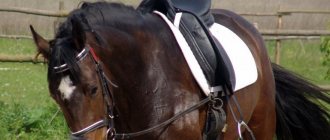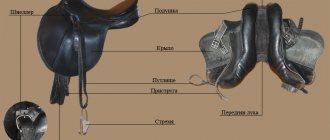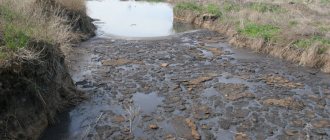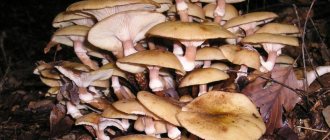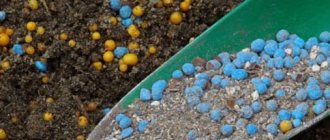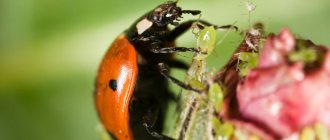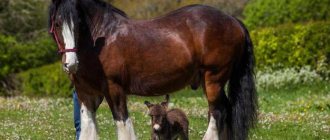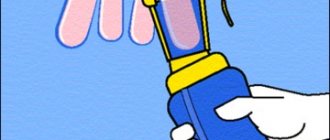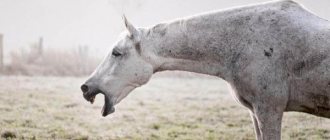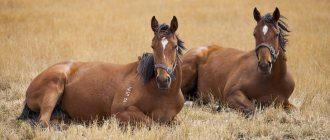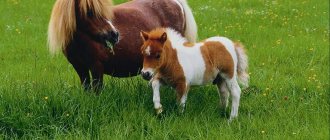Fastest movement
At a gallop, horses can reach their maximum speed. The recorded record currently is 71 km/h. Of course, a horse can maintain such indicators only over short distances, but a gallop is intended only for a sharp increase in speed, for example, to escape the pursuit of predators in natural conditions.
When galloping, the leading leg is highlighted - this is the forelimb, towards which the turn is made, and it also completes the running cycle.
Previously, it was believed that it was with the leading leg (that is, the front leg that the galloping movement began), many owners and horse breeders also continue to think so. But research has shown that at this stage of the gallop the front leg only completes the support phase, after which the push occurs.
Tact – alternation of movements at a gallop:
- gallop begins with support on the pelvic outer leg;
- then the internal pelvic and diagonal thoracic limbs are added to the support;
- The leading leg lands on the ground last;
- now the push phase occurs - the pelvic and outer forelimbs are the first to come off;
- the step is completed by lifting off the inside front leg – the leading one;
- followed by a period of jumping without support on the surface.
Gallop is usually distinguished by the speed and manner of movement of the horse. The fastest subtype is the quarry - this is running with large, frequent, sweeping steps and a long period of unsupported jumping. The quarry is accompanied by a lot of physical activity, so a horse can run at this pace only over a short distance - no more than 5 km, but at this distance it can show the maximum of its capabilities.
The fast gallop is also called the “three-cross gait.” This name is related to the army designations in the Russian cavalry. There was a division of horseback movement according to speed into three types - from one to three crosses. If the order was given to go “three crosses”, then this meant that you need to get to your destination as quickly as possible.
The canter is the basic type of movement and is also called the field canter or hand canter. Moving at this gait, a horse covers 1 km in an average of 2.5 minutes. It is used in horse racing and jumping over obstacles. But for quarry and dressage, the dressage gallop is used. In this case, the horse is “collected”, that is, the center of gravity is significantly shifted back. This allows you to increase maneuverability and quickly move from jumping to taking barriers of various configurations.
Basic rules of horse riding
Riding rules help reduce the rider's physical stress. They are as follows:
- Before starting the movement, the horse is “collected” (balanced) - bring your legs under the body and give in the head at the poll. Move your torso forward from the waist, increase the pressure of your legs and slightly tighten the reins;
- when moving in a straight line with the legs and reins, the horse is held straight; if it deviates, it is controlled using unilateral movements of the leg, pulling the reins on the opposite side of the deviation;
- the reins are pulled tight enough to feel the connection between the hands and the bridle;
- Do not use sudden movements unnecessarily.
Rules of conduct with a horse and installation:
- do not forget about common sense;
- a horse is a large animal that can intentionally or unintentionally cause damage to health, so safety should always come first;
- before you calmly go “at a walk” for a walk, you will need at least 10 riding lessons;
- you should not use trot and gallop gaits after the basic 10 lessons;
- You will need to learn the rules of falling and tuck.
Clothing is part of the rider's equipment. Traditional costumes consist of elastic trousers, leather chaps, a comfortable jacket made of soft fabric, long gloves and a helmet. The style that takes its origins from their equestrian uniforms is called derby. It's great for casual wear.
Classic set and types of clothing for riders:
- redingote - a long jacket;
- breeches - short trousers;
- chaps - boots;
- Amazon - women's costume;
- spurs (optional);
- helmet (helmet);
- cylinder - headdress for men;
- tailcoat - clothing for men.
Russian companies do not produce riding clothes, but they can be ordered from the studio. Thick knitwear is used for trousers. Seamless models are preferred, but if this is not possible, seam treatment is required to prevent chafing of the skin while driving
Pay attention to the specific cut of the trousers, which ensures a comfortable fit for the rider in the saddle
There are no uniform requirements for riding clothing; the cut of the uniform is dictated by convenience. For safety reasons, you will need a helmet; for convenience, good leather gloves that will protect the skin of your hands from mechanical damage from the reins.
There are three basic rules for galloping on a horse. They are also the three main conditions for learning how to put a horse into this gait.
- The right horse. This factor is the key. The animal must have a soft step and a comfortable fit. It must not only feel its rider well, but also be able to quickly carry out his commands. It is also important here that the horse can carry itself and go uphill with ease, and for this it needs stable limbs, especially the hind legs. Composure and balance are the main conditions for the landing of the animal to be successful and safe.
- A complete set of correctly selected ammunition. Without this, it will be impossible to raise the animal into a gallop with the correct execution of the technique. Therefore, it is necessary to ensure that this equipment includes a neck strap, bridle, cord, gog and saddle.
- The right place to train. When an animal gallops in an inconvenient training location, the gait technique is disrupted. Therefore, it is necessary to choose closed areas, with a large area and without sources of extraneous noise.
It is also necessary to follow the basic rules for transferring a horse from one gait to another. After all, this is the only way to send him from a trot to a gallop and back. The fact is that it is the accelerated step (trot) that is the variant of movement that precedes the gallop.
- Before you raise your horse into a gallop, you need to make sure it is ready. If the animal walks briskly and evenly, it is ready for this, but if it is sluggish and relaxed, then the time has not yet come for a gallop.
- The rider sits deeply in the saddle and with force pulls his left leg in front and up onto the girth, and with the opposite hand onto the back.
- With your right hand you pull the reins, but at the same time, on the left side, you slightly loosen it.
This procedure is performed when transferring the animal into a left-sided gallop. For the right-hand gait, all movements are performed with opposite hands and in other directions.
If the animal walks correctly, then all that is required of the rider is to maintain the leg in the given position.
If the horse was inexperienced or was not ready for the transition, then instead of rising to a gallop, it could go into a fast trot. In this case, it is transferred to the classic gait of this type, and after a couple of circles in the paddock, the attempt to rise into a gallop is repeated.
This type of riding, like galloping, is really simple and convenient for the animal and the rider, but only on the condition that they are both ready for such riding and have enough knowledge and practical experience.
Common gait
Trotting is a natural movement for most horses. Wild horses much more often use the trot to move around. A small percentage of horses amble from birth, but this is a less stable gait and often, when balance is disturbed, the animal returns to a trot. When moving at a trot, a horse cannot reach a high speed of 30 km/h, but this gait is needed for long-term movement. Trotters are used for both horseback riding and harness riding.
The trot is a symmetrical, diagonal gait - the left chest moves simultaneously with the right pelvic limb, and the right chest with the left pelvic limb. On each side there is an alternating movement of the hooves closer and further apart - horses can often experience locking when the hind hooves hit the front legs.
Between the supports on the ground there is a hanging phase - the faster the trot, the longer the horse is without support.
The trot is considered the worst gait for a rider due to the large pitching motion. At the same time, the vibrations are much stronger at the withers than at the croup, which makes horse riding even more difficult. Because of this, the practice of retraining horses is common. So, for running they use an amble, and instead of a trot - an accelerated step.
There are several types of lynx:
- trot – a slow type for demonstration runs;
- collected trot – also a leisurely gait, but with mass transferred to the croup;
- swing - faster running with an increased stride length and a short hanging phase, most often used for training;
- swing - an accelerated gait characterized by a large step. Horses are specially trained for this purpose;
- the frisky trot is the fastest type, differs from the swing by frequent steps.
In addition to the speedy types of trot, there are a number of irregular types. So, if the horse’s limbs do not move synchronously - the hind limbs are late, then such a trot is called a walk. When a horse gallops with its hind limbs, it produces a magpie trot, and when galloping with its chest legs, it produces a cape. And with an increased push of any of the pelvic limbs, there is a push.
Speed in harness
Traveling with a cart or cart requires a lower speed limit. Working draft horses usually walk or (very rarely) run at a quiet trot. It is possible to increase the speed without compromising the health of the animal if the traction force does not exceed 7-8% of the live weight.
The speed of a harnessed horse depends on several factors.
- The breed she belongs to. You should not expect the same result from working and riding horses.
- Weight of transported cargo. Accordingly, the increase in luggage weight reduces the speed of movement.
- Type of vehicle. A small, light cart rolls faster than a clumsy cart.
- Quality of the road surface. Driving on bad roads will be quiet. In addition, there are places where you can only travel on horseback.
Gait with side support
Ambling is an innate gait among a number of horses. Ambling can also be developed artificially by training with limbs tied in pairs. Pacers have advantages and disadvantages over trotters. On the one hand, they move faster and create less shaking for the rider, but on the other, one-sided support and sideways pumping lead to loss of balance. Because of this, ambling is considered an unstable gait - after stumbling, the horse quickly switches to a trot or gallop. Also, ambling is more tiring than trotting - the stride length is shorter, and speed is achieved by the frequency of moving the limbs .
Ambling is also common among other animals. Tall, broad-chested animals with an upwardly displaced center of gravity, long limbs and a short body are prone to it. This is how a giraffe, a bear, an elk, and a camel move.
Types of amble:
- foxtrot;
- tolt;
- Peruvian Paso;
- rack.
Everyone has always treated the amble differently. This gait was considered both a defect and a congenital gift. Therefore, there were schools that retrained trotters into pacers and vice versa. But if a pacer accustomed to trotting could show good results, because both gaits were natural for him, then a trotter at an amble suffered greatly. Such animals did not achieve much success and were discarded early due to deformations of the skeleton and hooves.
A woman dreamed of a horse
Big - achieve success, increase your well-being.
A running herd prophesies a rapid rise up the career ladder, victory in some important matter, or the fulfillment of a cherished dream.
For a woman, a dead horse in a dream is a bad sign, warning of separation from a partner, an outdated relationship. Another interpretation is huge losses that will be difficult to cope with.
Skinny and hungry - disagreements with loved ones due to financial situation, emotional turmoil, unpleasant news from afar.
An unmarried woman dreams of a horse grazing in a meadow with a foal - a long separation from a loved one.
Bites the dreamer - deceit, unexpected betrayal of a loved one.
Buying a young animal is a meeting with a person who was considered long lost
Old - significant losses await.
The horse attacks - quick attacks from others.
Feeding - additional income, or making a small profit.
Riders on horses - easy success in the near future.
For a married woman, riding a horse means possible betrayal.
Artificial types of movements
In addition to innate gaits, there are a number of acquired ones, developed by riders and trainers during the training process. There are a number of riding schools that hone a certain type of horse movement. Usually these are demonstrative gaits for various kinds of performances and demonstrations. Although training of this kind makes horses submissive and efficient, which has a positive effect on working under the rider.
Types of artificial gaits:
- passage - movement occurs in assembly. Steps occur in one quiet rhythm; on the rise, the limb is somewhat delayed;
- piaffe - movements are identical to the previous ones, but the legs rise higher, and the horse does not move;
- Spanish (school) walk - the horse moves with the pelvic limbs tucked under the body, and when throwing forward, the pectoral limbs are straightened at the elbow joint and stretched forward;
- Spanish trot - movements are similar to the previous gait, but the horse runs at a slow trot;
- pirouette - a galloping horse is forced to turn on its pelvic limbs;
- three-legged gallop - galloping with the chest leg raised and straightened at the elbow joint.
The greatest successes in teaching horses artificial gaits were achieved by the Spaniards, who created a higher riding school. The breeds that were bred in their time and trained in a special way were the most sought after throughout the world. The Spanish school is distinguished by the strict execution of all orders of the rider.
Horses must move together and obey the rider's orders at all times. Trained horses can easily move from one gait to another, perform a jump or a sharp turn. Such training was necessary for fighting in the days of knights, after which horses began to be used in bullfighting. And now such horses are used in show jumping and dressage.
From theory to practice: how to learn to ride a horse?
Horse Meet and Greet
Training horses are quite loyal to new riders and do not show aggression. If you are learning to ride a young owner's animal, try to have the owner with you during the first contact.
Gently pat the horse's neck, lightly patting it, and stroke it. Horses love such caresses and respond with friendliness. Aggressive behavior in domestic or training horses is extremely rare. This usually happens after receiving a negative experience from a person.
Sometimes an animal can behave unfriendly because it has health problems, is spoiled, or is so trained to communicate with “strangers.” In a poorly tuned animal, the ears are pressed back or erect, the legs are tense, the tail and head are raised up. Ears are also usually raised when eating and asking for treats.
Stroke the horse, saying kind words, until it relaxes and lowers its ears. These representatives of the animal world are sensitive to mood and timbre of voice.
Complementary foods can only be used with the permission of the instructor. Usually this type of taming is not used, but horses love sweets: dried fruits (dates, dried apricots), bread, sugar, watermelon, red carrots. You can purchase specialized complementary foods at a horse supply store.
Turn your back to the horse, press against the neck; if you want to show affection, throw the reins back. If this is done in the traditional way with a sharp jerking movement, the horse will react negatively.
Landing
When boarding, you can grab the mane at the withers; this is convenient and also not painful for the horse, since there are no nerve endings there. It is not recommended to hold onto the saddle due to the risk of it overturning. Pull the reins and grab it at the same time as the mane.
Place your left foot in the stirrup, jump up, holding the mane, and cross your right leg. Place your foot on the second stirrup and tighten the reins. You need to stay in the saddle with your thighs. Avoid sudden movement of the reins. Many horses are not used to this, so they may react harshly to painful movements of the reins and bridles.
Horses move if the rider makes characteristic movements or encourages her with his feet.
Step
The step is the basis of all gaits; it is the beginning of learning to ride a horse. There is no hanging phase in it, it is the slowest of all existing gaits, the horse moves at a speed of about 7 km/h , heavy trucks are even slower - 5 km/h.
The horse takes a step at 4 paces, touching the ground with two or three hooves at the same time. The horse moves in a diagonal manner, when the right front leg drops, the left leg from behind immediately moves forward. If the horse walks freely, then its muscles are relaxed, the neck is slightly stretched forward, and the head is lowered and swaying slightly.
A horse needs a free step so that after training he can relax a little, rest and dry out. This is where training begins so that the horse can warm up; this is the first stage of training the animal.
With a collected movement, the neck rises, the step becomes clear, the limbs rise higher, the lower back tucks in, if you look at the tracks, the prints of the front and hind legs almost coincide.
With an increased stride, the animal moves sweepingly, the tracks of the hind hooves are ahead of the front ones, the lower back is extended. With this step, the horse is ready to move to any gait on command. The movement begins with the hind leg, the step length is equal to a meter, and on average the horse takes 100 steps per minute .
Amble
A pacer is a horse that moves with the rarest and most original type of gait - ambling. This type of movement is typical only for a small group of horses and is highly appreciated by riders. Ambling is a little similar to trotting, but this is only at first glance. The difference is that the horse carries its limbs only on one side, and not, as during a trot, diagonally.
Amble
A pacer horse, compared to a trotter, has a shorter stride length, although it moves its hooves with greater frequency. Therefore, such a horse develops high speed: it runs a distance of one kilometer in 2 minutes. With a rider, a pacer can cover a distance of 100-120 km per day. It is quite difficult to switch from one type of gait to another horse. These are natural horses, so pacers are not used for transporting goods.
